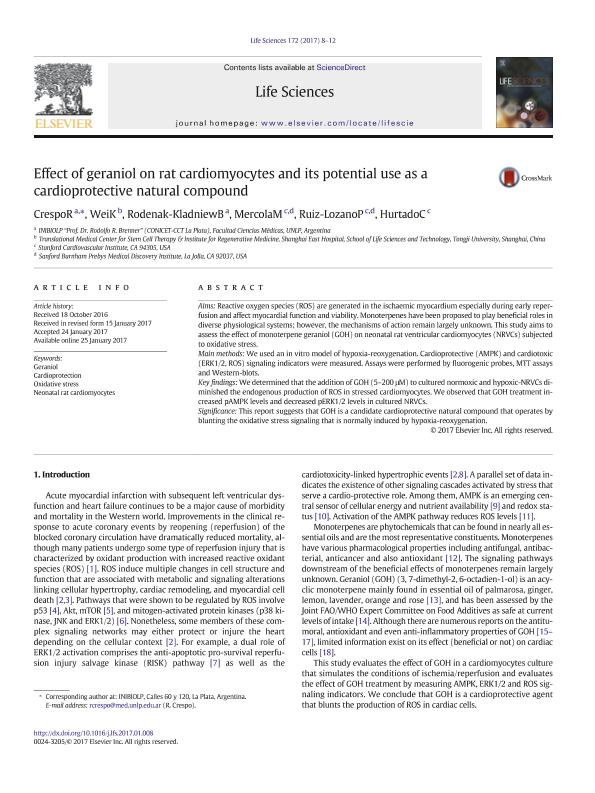Artículo
Effect of geraniol on rat cardiomyocytes and its potential use as a cardioprotective natural compound
Crespo, Rosana ; Wei, K.; Rodenak Kladniew, Boris Emilio
; Wei, K.; Rodenak Kladniew, Boris Emilio ; Mercola, Mark; Ruiz Lozano, P.; Hurtado, C.
; Mercola, Mark; Ruiz Lozano, P.; Hurtado, C.
 ; Wei, K.; Rodenak Kladniew, Boris Emilio
; Wei, K.; Rodenak Kladniew, Boris Emilio ; Mercola, Mark; Ruiz Lozano, P.; Hurtado, C.
; Mercola, Mark; Ruiz Lozano, P.; Hurtado, C.
Fecha de publicación:
01/2017
Editorial:
Pergamon-Elsevier Science Ltd
Revista:
Life Sciences
ISSN:
0024-3205
Idioma:
Inglés
Tipo de recurso:
Artículo publicado
Clasificación temática:
Resumen
Aims Reactive oxygen species (ROS) are generated in the ischaemic myocardium especially during early reperfusion and affect myocardial function and viability. Monoterpenes have been proposed to play beneficial roles in diverse physiological systems; however, the mechanisms of action remain largely unknown. This study aims to assess the effect of monoterpene geraniol (GOH) on neonatal rat ventricular cardiomyocytes (NRVCs) subjected to oxidative stress. Main methods We used an in vitro model of hypoxia-reoxygenation. Cardioprotective (AMPK) and cardiotoxic (ERK1/2, ROS) signaling indicators were measured. Assays were performed by fluorogenic probes, MTT assays and Western-blots. Key findings We determined that the addition of GOH (5–200�μM) to cultured normoxic and hypoxic-NRVCs diminished the endogenous production of ROS in stressed cardiomyocytes. We observed that GOH treatment increased pAMPK levels and decreased pERK1/2 levels in cultured NRVCs. Significance This report suggests that GOH is a candidate cardioprotective natural compound that operates by blunting the oxidative stress signaling that is normally induced by hypoxia-reoxygenation.
Palabras clave:
Cardioprotection
,
Geraniol
,
Neonatal Rat Cardiomyocytes
,
Oxidative Stress
Archivos asociados
Licencia
Identificadores
Colecciones
Articulos(INIBIOLP)
Articulos de INST.DE INVEST.BIOQUIMICAS DE LA PLATA
Articulos de INST.DE INVEST.BIOQUIMICAS DE LA PLATA
Citación
Crespo, Rosana; Wei, K.; Rodenak Kladniew, Boris Emilio; Mercola, Mark; Ruiz Lozano, P.; et al.; Effect of geraniol on rat cardiomyocytes and its potential use as a cardioprotective natural compound; Pergamon-Elsevier Science Ltd; Life Sciences; 172; 1-2017; 8-12
Compartir
Altmétricas



